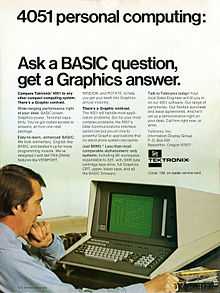Tektronix 405x

The Tektronix 405x series was a series of graphics microcomputers produced by Tektronix in the late 1970s through the early 1980s. The display technology was similar to the Tektronix 4014 terminal, using a storage tube display to avoid the need for video RAM. The 4051 and 4052 included a CPU, up to 32 kilobytes of RAM, keyboard, 11" CRT and full-sized 300 kilobyte 3M DC-300 series high speed data cartridge (as opposed to the cassette tape drive used by the HP 9830) to the right of the CRT in a single, desktop-sized housing. All models included a GPIB parallel bus interface for controlling lab and test equipment and external input and output peripherals. A simple operating system and BASIC interpreter were included in ROM. A hard copy device was available which made copies of the screen.
External storage units were available for the 405x series computers. The smaller, desktop 4907 storage unit used single or dual Shugart 851R 8 inch floppy drives with 64 kilobyte floppies and the larger, 2-drawer filing cabinet sized, 4909 storage unit used a CDC 96 megabyte hard drive with the first 16 megabytes in the form of a removable disc-pack. A 4924 external tape drive used the same tape cartridges as the in-board unit.
The 4050 series was popular at a time when many companies were struggling to make the transition from paper to digital. Two sizes of the 4956 graphics tablet offered a slow process for inputing from paper drawings.
The 4051 microcomputer used a Motorola 6800 (an 8-bit microcontroller);[1] the 4052 and later models used bit slice 16-bit CPUs for speed. These 4054 featured a 19" storage tube display that was also capable of a limited (and rather dim) write-through mode (not storing the image). The computers were popular in research laboratories and other locations where interactive plotting was important, as the storage tube video yielded much higher quality output than comparably priced RAM-based solutions of the day. The 405x series met its demise in the late 1980s as video-RAM based graphics cards became cheap and powerful enough to enable high quality plotting in commodity computers without the restrictions of the storage tube CRT.
Because the direct view storage tubes do not flicker as do conventional CRTs, and because the BASIC programming interface allowed simple, rapid rendering of vector graphic displays, the 405x series were used in many theatrical contexts. In particular, 405x computers can frequently be seen in early Battlestar Galactica sets.
The graphic display software was based upon software originally developed in the 1960s by Corning Glass Works for their Type 904 graphics terminal. The display for this system had characteristics to the similar to those of Tektronix storage tube display. It used small pixel regions composed of photochromic glass, which could be darkened (forming a black line image) by writing, and would display this persistently until the entire display was erased. When Corning left the market this software base was sold to Tektronix.
The original demo included an artillery game which was later adapted by high school students at Lindbergh High School in Renton, Washington to the HP 9830, and also adapted by Hewlett Packard for the HP 2647 intelligent graphics terminal demo tape and eventually similar games in Microsoft BASIC for the IBM-PC. Other games for the Tektronix included Weather Wars, with users directing lightning bolts and tornados against opponents in an environment affected by wind.
References
- ↑ http://www.atariarchives.org/bcc2/showpage.php?page=282 A Creative Computing Equipment Profile -- Tektronix 4051 Graphics System
External links
- A Creative Computing Equipment Profile -- Tektronix 4051 Graphics System
- Tektronix 4052 System
- Drawing lines on 4052 video
- Description of a 4051 BASIC and graphics simulator for Windows
- Demo video for the 4051 BASIC and graphics simulator for Windows
| ||||||||||||||||||